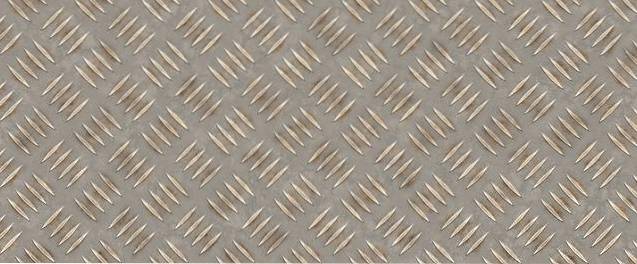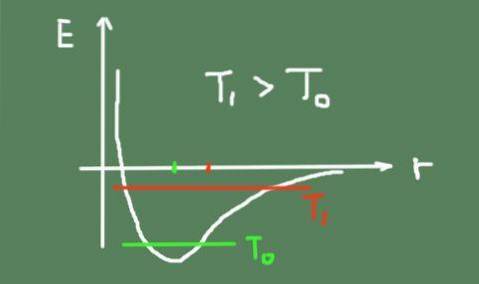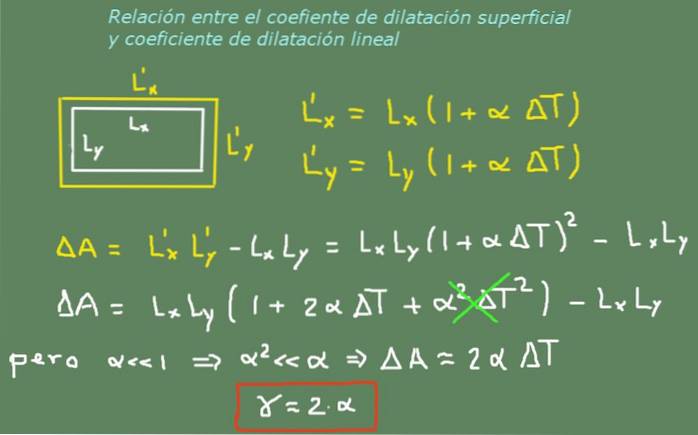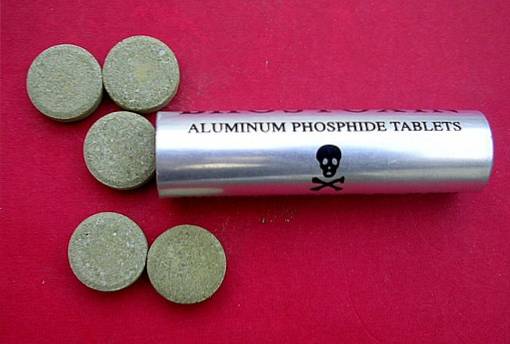
Surface dilation formula, coefficients and examples
The superficial dilation It is the expansion that occurs when an object experiences variations in its surface due to a variation in temperature. It is due to the characteristics of the material or its geometric shape. The dilation predominates in two dimensions in the same proportion.
For example, in a sheet, when there is a change in temperature, it is the surface of the sheet that undergoes the greatest change due to thermal expansion.

The metal sheet of the previous figure increases its width and its length appreciably when it is heated by solar radiation. On the contrary, both decrease significantly when it is cooled due to a decrease in ambient temperature..
It is for this reason that, when tiles are installed on a floor, the edges should not stick together, but there must be a gap called an expansion joint..
In addition, this space is filled with a special mixture that has a certain degree of flexibility, preventing the tiles from cracking due to the strong pressures that thermal expansion can produce..
Article index
- 1 What is superficial dilation?
- 2 Surface dilation and its coefficient
- 3 Coefficient of surface expansion for various materials
- 4 Worked Examples of Surface Expansion
- 4.1 Example 1
- 4.2 Example 2
- 5 References
What is superficial dilation?
In a solid material the atoms maintain their relative positions more or less fixed around an equilibrium point. However, due to thermal agitation, they are always oscillating around the same.
As the temperature increases, the thermal oscillation also increases, causing the middle oscillation positions to change. This is because the binding potential is not exactly parabolic and has asymmetry around the minimum.
Below is a figure that outlines the chemical bond energy as a function of the interatomic distance. The total energy of oscillation at two temperatures and how the center of oscillation moves is also shown..

Superficial dilation and its coefficient
To measure the surface dilation, we start from an initial area A and an initial temperature T, of the object whose dilation is to be measured..
Suppose that said object is a sheet of area A, and its thickness is much less than the square root of area A. The sheet is subjected to a temperature variation ΔT, such that its final temperature once the thermal equilibrium with the heat source has been established, it will be T '= T + ΔT.
During this thermal process, the surface area will also have changed to a new value A '= A + ΔA, where ΔA is the change in length. Thus, the coefficient of surface expansion σ is defined as the quotient between the relative variation of area per unit of temperature variation.
The following formula defines the coefficient of surface expansion σ:

The coefficient of surface expansion σ is practically constant over a wide range of temperature values.
By the definition of σ its dimensions are inverse of temperature. The unit is usually ° C-1.
Coefficient of surface expansion for various materials
Next we will give a list of the coefficient of superficial expansion for some materials and elements. The coefficient is calculated at normal atmospheric pressure based on an ambient temperature of 25 ° C, and its value is considered constant in a range of ΔT from -10 ° C to 100 ° C.
The unit of the coefficient of surface expansion will be (° C)-1
- Steel: σ = 24 ∙ 10-6 (° C)-1
- Aluminum: σ = 46 ∙ 10-6 (° C)-1
- Gold: σ = 28 ∙ 10-6 (° C)-1
- Copper: σ = 34 ∙ 10-6 (° C)-1
- Brass: σ = 36 ∙ 10-6 (° C)-1
- Iron: σ = 24 ∙ 10-6 (° C)-1
- Glass: σ = (14 to 18) ∙ 10-6 (° C)-1
- Quartz: σ = 0.8 ∙ 10-6 (° C)-1
- Diamond: σ = 2,, 4 ∙ 10-6 (° C)-1
- Lead: σ = 60 ∙ 10-6 (° C)-1
- Oak wood: σ = 108 ∙ 10-6 (° C)-1
- PVC: σ = 104 ∙ 10-6 (° C)-1
- Carbon fiber: σ = -1.6 ∙ 10-6 (° C)-1
- Concrete: σ = (16 to 24) ∙ 10-6 (° C)-1
Most materials stretch with an increase in temperature. However, some materials such as carbon fiber shrink with increasing temperature..
Worked Examples of Surface Expansion
Example 1
A steel plate has dimensions of 3m x 5m. In the morning and in the shade its temperature is 14 ° C, but at noon the Sun heats it up to 52 ° C. Find the final area of the plate.
Solution
We start from the definition of the coefficient of surface expansion:

From here we solve for the variation in the area:

We then proceed to substitute the respective values to find the increase in area by the increase in temperature.

That is, the final area will be 15,014 square meters.
Example 2
Show that the coefficient of surface expansion is approximately twice the coefficient of linear expansion.
Solution
Suppose that we start from a rectangular plate of dimensions width Lx and length Ly, then its initial area will be A = Lx ∙ Ly
When the plate undergoes a temperature increase ΔT, then its dimensions also increase being its new width Lx 'and its new length Ly', so that its new area will be A '= Lx' ∙ Ly '

The variation suffered by the area of the plate due to the change in temperature will then be
ΔA = Lx '∙ Ly' - Lx ∙ Ly
where Lx '= Lx (1 + α ΔT) and Ly' = Ly (1 + α ΔT)
That is, the change in area as a function of the coefficient of linear expansion and the change in temperature will be:
ΔA = Lx (1 + α ΔT) ∙ Ly (1 + α ΔT) - Lx ∙ Ly
This can be rewritten as:
ΔA = Lx ∙ Ly ∙ (1 + α ΔT) ² - Lx ∙ Ly
Developing the square and multiplying we have the following:
ΔA = Lx ∙ Ly + 2α ΔT Lx ∙ Ly + (α ΔT) ² Lx ∙ Ly - Lx ∙ Ly
Since α is of the order of 10-6, when squared it is of the order of 10-12. Thus, the quadratic term in the above expression is negligible.
Then the increase in area can be approximated by:
ΔA ≈ 2α ΔT Lx ∙ Ly
But the increase in area as a function of the coefficient of surface expansion is:
ΔA = γ ΔT A
From which an expression is derived that relates the coefficient of linear expansion with the coefficient of surface expansion.
γ ≈ 2 ∙ α
References
- Bauer, W. 2011. Physics for Engineering and Sciences. Volume 1. Mac Graw Hill. 422-527
- Giancoli, D. 2006. Physics: Principles with Applications. 6th. Edition. Prentice Hall. 238-249.



Yet No Comments